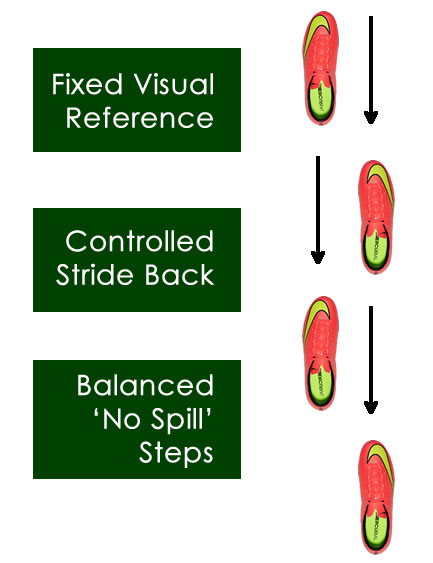How to Step Back for Field Goals
In this post, I’m going to address something that seems so fundamental to most kickers that they don’t give it a second thought. However, do this incorrectly, and you may find yourself in the wrong position for many of your field goals. Why miss an easy kick that could have easily been prevented with good habits at setup?
 Whether you are a beginner or an advanced kicker with game experience, field goal steps can be one area of kicking that can easily help your consistency. Remember, the field goal kick contains not only setup, but lots of moving parts.
Whether you are a beginner or an advanced kicker with game experience, field goal steps can be one area of kicking that can easily help your consistency. Remember, the field goal kick contains not only setup, but lots of moving parts.
There are factors during the kick that we can not control that may contribute to a bad kick (like the hold, the snap, the wind, etc) and I often refer to these elements as “outside the bubble” factors.
However, taking proper and consistent steps is something that will help our odds simply put. When I work with a new kicking student, in almost every case they have at a minimum, the concept of three steps back and two steps over. It’s how most every NFL and college kicker sets up to kick a field goal and how I’ve setup for my kicks from the beginning.
I won’t get into ‘why’ that is a common amount of steps in this post. I simply want to address how we take the steps back, because I’ve seen so many inconsistencies over the years with kicking students that it is worth discussing.
We are going to address two main factors in the setup steps, no matter how many steps you take!
- Where you look while stepping back
- How long your stride is while stepping back
Each of these things can affect your setup and can honestly only get worse as you move out to the hash marks for your kicks.
Where Should I Look While Stepping Back?
This is probably one of the most overlooked areas of setup. Where DO you look when stepping back? I’m talking about the three steps back part of the typical three back, two over (or however many steps back you do take ultimately).
I will say, many beginners have a tendency to look down at the ground when they step back. Others kind of ‘look around’ randomly as they step back, to the side, up, down, etc.
What I’m going to suggest to any new (or experienced) kicker is that they focus on a fixed point during the back step process. Why? Two reasons really.
- Walking backwards without stabilizing your head can lead to inconsistent steps. In fact, kickers (especially beginners) can sometimes look like drunken sailors as they move backwards awkwardly to hit that final stopping point. It’s just difficult to “consistently” move backwards in a straight line this way, and our setup is always based on perfectly straight, imaginary target lines. So, it can affect our balance, which can lead to staggered steps of differing lengths off of our target line.
- Once we are “off our line” stepping back, even just an inch or two, it ensures that our side steps are going to be at the wrong angle. This will put us in a position of misalignment as we then step “into” our kick.
The logic behind the fixed point back steps is that field goal setup (our steps) is based on imaginary lines and angles.
 It’s a bit like a blue print that kickers follow to determine where to stand and what direction to move the body during the swing.
It’s a bit like a blue print that kickers follow to determine where to stand and what direction to move the body during the swing.
If you don’t follow your natural momentum lines, you probably won’t find much consistency with your kicking.
Imagine standing sideways in the driveway to shoot a basketball free throw. Then facing the opposite direction the next shot from the same spot.
The basket ball goal hasn’t moved, but by changing our body each time, we are making it twice as tough to get into a rhythm of any kind. We are creating extra work with each repetition.
Balance is a factor here as well. Think about when we run, we generally keep our eyes focused in front of us. It keeps us balanced and stable as we move.
Would you run your timed 40 yard dash by looking left, then right, then up as you sprinted down the field? Not only would that be distracting, the extra movement of the head, neck and shoulders would not be efficient. It would certainly slow our ‘gate’ as we moved.
So, focusing on a fixed point (the field goal center post is perfect) as we step back can help ensure that we step in a straight line with better balance. That will help keep the distance between each step as close as possible.
How Big Should My Steps Back Be?
As I always like to point out during private kicking lessons, three steps isn’t always three steps, which is where most of our setup issues come into play.
I’ve watched kickers take back steps around 12 inches in stride on one kick, only to follow by 15 inches on the very next kick. Others take progressively larger strides back with each step, say 10 inches, then 15, then 18 or so.
Remember the following:
- Each step back should be the same distance.
- The distance should not be too short or too long, but comfortable.
I’ll often have students walk backwards about 15-20 yards in a controlled fashion until they hit a comfortable, natural walking stride. It’s the kind that takes you from point A to point B without feeling like your bouncing or reaching as you walk.
Imagine a glass of water on your head as you step back. With each step, try not to spill the water! By keeping the head as steady as possible so that the imaginary water won’t slosh out of the glass, we can start to ‘control’ the stride of those back steps.
This may take some practice, but the 15-20 yard ‘walking backwards comfortably without spilling imaginary water’ drill is always a good way to get in a rhythm before kicking practice for beginners.
To Sum Up The Back Steps
Remember, taking those initial back steps sets the initial tone for your kick. It sounds crazy I know, but practicing the back steps for your setup is an easy but important factor in consistent kicking. It’s just one less thing to worry about when you have it down, and the habit can save you during your next game winning field goal so make it a priority!
I’ll talk about the side steps in another post, just remember to MAKE THE BACKSTEPS COUNT and the rest of your setup will fall into line!
